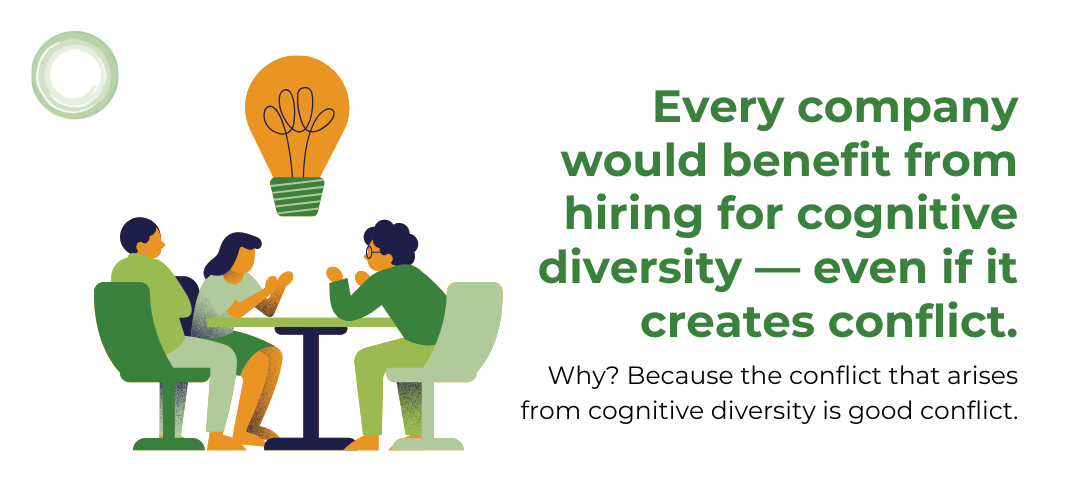When you imagine an incredibly effective, successful team meeting, what does it look like?
For some people, it looks like this: One person talking while everyone nods. Someone is taking notes while muttering, “Yes, I think so too!” The leader wraps the meeting by asking, “So we’re all in agreement?” And everyone cheers, “Yes!”
Now, I love a smoothly run meeting as much as the next person, but I also know you do not want a completely conflict-free team. It’s not good for your company (or your clients or margins) to be staffed exclusively by people who share the same worldview, the same personality type, or the same approach to business.
In fact, every company would benefit from hiring for cognitive diversity — even if it creates conflict.
Why? Because the conflict that arises from cognitive diversity is good conflict.
Want to build a team that thrives on healthy debate and creative tension? Discover how our Enneagram-based coaching helps you assess and optimize your team’s cognitive diversity.
It’s conflict that results in better products, happier customers, more effective systems, and fewer missteps.

What is cognitive diversity?
A team that’s cognitively diverse is a team that’s made up of people with different mindsets, motivations, and approaches to problem-solving. In the parlance of the Enneagram, it means that your team has a diversity of leadership styles: a 4, 7, 1, 8, 2, 7, 6, and 3.
The truth is the team that has five Type 7s (the enthusiastic visionary types, who are filled with ideas) and one Type 6 (the loyal skeptic who keeps pointing out all the ways these ideas won’t work) may not be as effective as you would like.
We all have blind spots … and people with the same Enneagram type generally have the same blind spots. When we fill a team with cognitively homogeneous individuals, we’re strengthening and deepening those blind spots. We need cognitive diversity on our teams to get a full, 360-degree view of perspectives for better decision-making.
If everyone on the team is a Type 7, who’s going to see all the potential pitfalls of acquiring that new company? Who’s going to naturally pick up on the errors in the financial statement?
Or to use a different metaphor, when a team is cognitively diverse, we’re playing with a full roster — a quarterback, running back, wide receivers, tight end, etc. As a devout Pittsburgh Steelers fan, the thought of an unbalanced offense or defense makes me cringe. And yet many CEOs fill their offices with 70% running backs and 30% tight ends. That’s no way to win a championship.
Just like a winning team needs every position filled, your leadership team needs a full range of cognitive styles. Learn how to apply this model in our High-Performing Teams program.
What sort of conflict arises from cognitive diversity?
Each of the 9 Enneagram types see the world differently. This means they approach problem solving differently … which will lead to conflict. Again, the conflict this creates is good conflict.
Let’s say your company is launching a new offering.
Here’s what a launch meeting filled with cognitively diverse people might look like:
The Type 8 (Powerful Challenger) is describing the big picture and telling everyone what to do.
The 7 (Enthusiastic Visionary) has a really fun launch idea involving a dancing flash mob.
The 6 (Skeptical Troubleshooter) is pointing out the various flaws in this idea.
The 1 (Principled Reformer) has found several typos in the marketing copy and is trying to talk about it.
The 3 (Productive Performer) is concerned about the optics on this new launch. What will people think about us as a result?
While everyone is talking over one another, the 9 (Modest Mediator) is trying to calm people down and help them get along.
This might sound like an incredibly stressful meeting, but the results that come out of this meeting will be better because of all the different personality types present.
If the Type 6 hadn’t pointed out the flaws, the offering might have fallen apart once it got to market; if the Type 1 hadn’t found those typos, the company would have spent thousands of dollars getting everything reprinted.
A cognitively diverse team will lead to better products and better profits.
How do you make sure you have a cognitively diverse team?
Just realizing the importance of cognitive diversity is a huge step in the right direction.
Your next step is learning more about the leadership styles of your current team — who’s a “helper”? Who’s a “peacemaker”? Bring in an Enneagram expert and find out!
Once you know each team member’s Enneagram type, you can learn more about their paths to growth. You might also have more empathy and appreciation for each other. When Chris points out all the holes in the plan, he’s not being a jerk. He’s making sure the plan is successful — that’s what Type 6s do!
And if it’s time to hire someone? Consider the holes in your team — who’s missing? Do you need a Peacemaker? Or a Performer? If you already have four Performers on your team, I think you know the answer.
Want to know more? I talk more about the importance of cognitive diversity on this podcast interview. Click here to learn more about the power of diverse leadership styles and how that supports your business.


